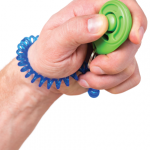The Process
The process of obtaining a service dog varies by organization. At Canine Partners for Life, interested candidates must first complete an application that requires documentation of their diagnosis. “Trainers will review the application, and if they feel an applicant would be a good candidate, they schedule a face-to-face interview,” Ms. Sneath-Zeiders says. “During the interview, trainers get to know the applicant, talk about how a service dog could help them specifically and answer their questions. If accepted into the program, candidates wait from one to three years before being matched with a dog.”
After the company identifies a potential match, the patient may be asked to come to the facility to see if the dog’s activity level and personality are a good match for the applicant. Three weeks of intensive training for the patient and dog follow, which includes basic obedience; use of skills; and legal knowledge of what a service dog may and may not do and where it can go. Basic medical and care knowledge is also reviewed.
A Personal Experience
In 2012, after her rheumatologist approved of her getting a service dog, Sue Peetoom, 67, of Green Valley, Ariz., was matched with a Labrador Retriever named Mina.
“Mina assists me in many ways,” says Ms. Peetoom, who suffers from RA, osteoarthritis and fibromyalgia. “Primarily, she supports me and helps me stay balanced when moving, especially on unlevel terrain. She also assists when I just don’t have the energy to move myself forward. She’s great with various tasks, such as picking up something I’ve dropped and bringing it to me, unloading my front-loading dryer so I don’t have to bend [over] and carrying parcels.”
Ms. Peetoom says, “To have a service dog is life changing. Mina’s physical and emotional assistance has allowed me to return to a more active lifestyle and helped reduce my pain and tiredness because of the work she does for me. However, it is a tremendous commitment. Once the leash is in your hands, your dog is with you 24/7/365 for the rest of their life.”
Mina also helps Ms. Peetoom socialize. “[Mina] is a good initiator of social contact and interaction, stopping me from becoming a recluse,” she says. “Many people stop and admire her and ask questions. She gives me confidence. The time, effort and commitment are very worthwhile. Life with a canine partner is a joy.”
Karen Appold is a medical writer in Pennsylvania.



